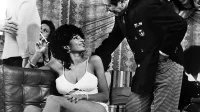The Legacy of Blaxploitation Cinema
Over half a century later, films now categorized as “blaxploitation” continue to captivate audiences, drawing packed houses during revival screenings. This term originated from the marketing strategies employed by American International Pictures, the very studio responsible for producing these iconic films.
Understanding the Term “Blaxploitation”
According to actress Pam Grier, who starred in several of these influential movies, the term was designed to signal exhibitors that these films catered specifically to a Black audience. Marketers noted that the content—the culture, food, dialogue, and cars like the “deuce and a quarter”(the Buick Electra 225)—would resonate with viewers. “They would know how to book that project, that film, and what region to book it in,” Grier explains.
However, Grier also points out the term was politically charged, created to undermine Black support for these films in favor of mainstream alternatives. It was essentially a strategic marketing tactic intended to deter Black audiences.
The Origins of the Genre
The genesis of the term can be traced back to Junius Griffen, president of the Beverly Hills-Hollywood branch of the NAACP, who is credited with combining “Black”and “exploitation”to critique the genre’s portrayal of sex and violence as perpetuating harmful stereotypes against the African-American community.
Despite its negative connotations, many viewers began to embrace blaxploitation films during a time of social upheaval marked by the civil rights and Black Power movements. These films offered Black protagonists who inspired empowerment and self-identification within Hollywood.
Breaking Down the Exploitation Narrative
Grier emphasizes that the genre was not solely focused on Black themes but reflected a broader culture of exploitation prevalent in the film industry. “There was white exploitation, Black exploitation. It’s all exploitation — everybody’s shooting and killing, and it’s funded by white filmmakers,” she notes. This dynamic led to the emergence of iconic characters like those in “Shaft”and “Superfly,”who acted as modern-day Robin Hoods—standing up against the affluent and protecting their communities.
The Economics of Exploitation in Hollywood
The usage of “exploitation”in film discourse also relates to an age-old practice in industry publications, such as The Hollywood Reporter, which often described films in terms of their profit potential. There was a tendency to emphasize how much revenue theater owners could anticipate from various titles, further embedding the concept within cinematic language.
Pam Grier and Feminism in Blaxploitation
Grier also touches on an unexpected element of feminism associated with the term “blaxploitation.””It wasn’t called ‘exploitation’ until I walked in a man’s shoes,” she asserts while reflecting on her iconic role in “Coffy.”Grier used martial arts, firearms, and embodied a strength that challenged traditional gender norms. “Maybe they meant it was ‘exploiting’ the woman, the little woman who’s not supposed to fight for herself,” she remarks, challenging stereotypes and emphasizing the necessity for women to take action when their protectors are absent.
Explore Blaxploitation Cinema
For those interested in revisiting Grier’s groundbreaking works and other films that shaped the era of Black empowerment, a selection is available on Pam Grier’s Soul Fix channel. This platform promises “an adrenaline-fueled journey through the era of Black empowerment” and is accessible via the Roku Channel and Plex.tv.


